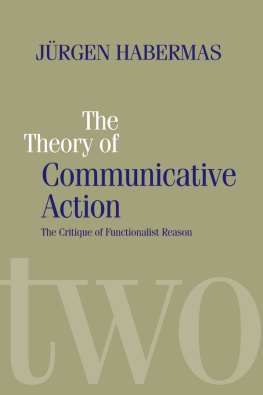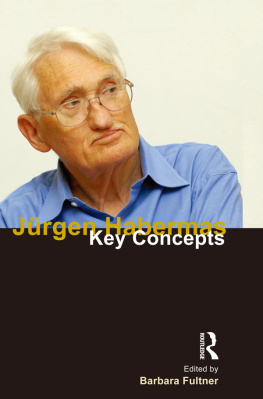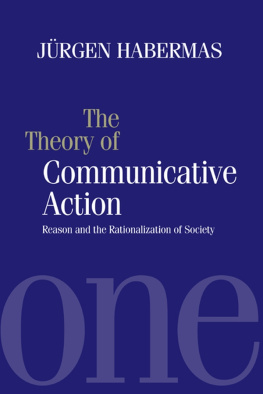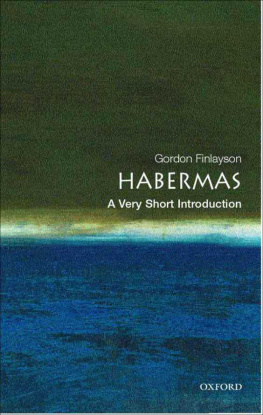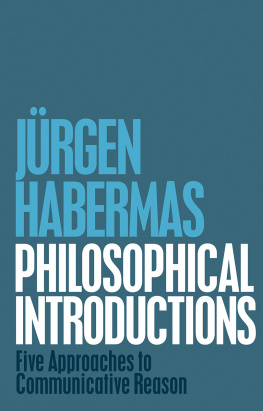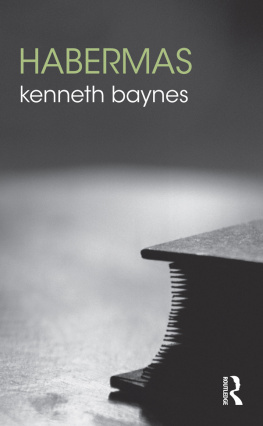

First published in 1981 as Theorie des kommunikativen Handelns, Band 2: Zur Kritik der funktionalistischen Vernunft by Suhrkamp Verlag, Frankfurt am Main
Translators preface and translation copyright Beacon Press 1987
This edition first published in 1987 by Polity Press in association with
Blackwell Publishers Ltd.
First published in paperback 1989
Reprinted in 1992, 1995, 1998, 2004, 2006
Editorial office:
Polity Press
65 Bridge Street
Cambridge CB2 1UR, UK
Marketing and production:
Blackwell Publishers Ltd
108 Cowley Road
Oxford OX4 1JF, UK
All rights reserved. Except for the quotation of short passages for the purposes of criticism and review, no part of this publication may be reproduced, stored in a retrieval system, or transmitted, in any form or by any means, electronic, mechanical, photocopying, recording or otherwise, without the prior permission of the publisher.
Except in the United States of America, this book is sold subject to the condition that it shall not, by way of trade or otherwise, be lent, re-sold, hired out, or otherwise circulated without the publishers prior consent in any form of binding or cover other than that in which it is published and without a similar condition including this condition being imposed on the subsequent purchaser.
ISBN 0745607705 (pbk)
A CIP catalogue record for this book is available from the British Library.
Translators Preface
In preparing this translation, I was greatly reassured by the authors willingness to read through a first draft and suggest whatever changes he thought appropriate. The reader should be advised that, while these changes were introduced to capture more precisely his meaning or to make the translation more readable, they often resulted in minor departures from the original text. At such points, then, the correspondence between the German and English versions is not exactly that of translation.
I am indebted to Victor Lidz and Jeffrey Alexander for reading and commenting upon the translation of Chapter VII, and to Robert Burns and Carol Rose for helping with the legal terminology in Chapter VIII. I am particularly grateful to Sydney Lenit, Marina Rosiene, and Claudia Mesch for undertaking the hardly inconsiderable task of typing and retyping the manuscript.
Thomas McCarthy
Northwestern University
V
The Paradigm Shift in Mead and Durkheim: From Purposive Activity to Communicative Action
In the Marxist reception of Webers theory of rationalization, from Lukacs to Adorno, the rationalization of society was always thought of as a reification of consciousness. As I have argued in Volume 1, the paradoxes to which this conceptual strategy leads show that rationalization cannot be dealt with adequately within the conceptual frame of the philosophy of consciousness. In Volume 2 I will take up the problematic of reification once again and reformulate it in terms of, on the one hand, communicative action and, on the other, the formation of subsystems via steering media. Before doing so I shall develop these basic concepts in the context of the history of social theory. Whereas the problematic of rationalization/reification lies along a German line of social-theoretical thought running from Marx through Weber to Lukacs and Critical Theory, the paradigm shift from purposive activity to communicative action was prepared by George Herbert Mead and Emile Durkheim. Mead (1863 1931) and Durkheim (18581917) belong, like Weber (18641920), to the generation of the founding fathers of modern sociology. Both developed basic concepts in which Webers theory of rationalization may be taken up again and freed from the aporias of the philosophy of consciousness: Mead with his communication-theoretic foundation of sociology, Durkheim with a theory of social solidarity connecting social integration to system integration.
The ideas of reconciliation and freedom, which Adornowho in the final analysis remained under the spell of Hegelian thoughtmerely circled around in a negative-dialectical fashion, stand in need of explication. They can in fact be developed by means of the concept of communicative rationality, toward which their use by Adorno points in any case. For this purpose we can draw upon a theory of action that, like Meads, is concerned to project an ideal communication community. This Utopia serves to reconstruct an undamaged intersubjectivity that allows both for unconstrained mutual understanding among individuals and for the identities of individuals who come to an unconstrained understanding with themselves. The limits of a communication-theoretic approach of this sort are evident. The reproduction of society as a whole can surely not be adequately explained in terms of the conditions of communicative rationality, though we can explain the symbolic reproduction of the life world of a social group in this way, if we approach the matter from an internal perspective.
In what follows, I will (1) examine how Mead develops the basic conceptual framework of normatively regulated and linguistically mediated interaction; he arrives at this point by way of a logical genesis, starting from interaction mediated by gestures and controlled by instincts, and passing through the stage of symbolically mediated interaction in signal languages. (2) In the transition from symbolically mediated to normatively guided interaction, there is a gap in the phylogenetic line of development which can be filled in with Durkheims assumptions concerning the sacred foundations of morality, the ritually preserved fund of social solidarity. (3) Taking as our guideline the idea of a linguistification [Versprachlichung] of this ritually secured, basic normative agreement, we can arrive at the concept of a rationalized lifeworld with differentiated symbolic structures. This concept takes us beyond the conceptual limitations of the Weberian theory of action, which is tailored to purposive activity and purposive rationality.
1. The Foundations of Social Science in the Theory of Communication
Early in the twentieth century, the subject-object model of the philosophy of consciousness was attacked on two frontsby the analytic philosophy of language and by the psychological theory of behavior. Both renounced direct access to the phenomena of consciousness and replaced intuitive self-knowledge, reflection, or introspection with procedures that did not appeal to intuition. They proposed analyses that started from linguistic expressions or observed behavior and were open to intersubjective testing. Language analysis adopted procedures for rationally reconstructing our knowledge of rules that were familiar from logic and linguistics; behavioral psychology took over the methods of observation and strategies of interpretation established in studies of animal behavior.
Despite their common origins in the pragmatism of Charles Sanders Peirce, these two approaches to the critique of consciousness have gone their separate ways and have, in their radical forms, developed independent of one another. Moreover, logical positivism and behaviorism purchased their release from the paradigm of the philosophy of consciousness by reducing the traditional roster of problems with a single coup de mainin one case through withdrawing to the analysis of languages constructed for scientific purposes, in the other by restricting itself to the model of the individual organisms stimulus-induced behavior. The analysis of language has, of course, freed itself from the constrictions of its dogmatic beginnings. The complexity of the problematic developed by Peirce has been regained along two pathsone running from Carnap and Reichenbach through Popper to postempiricist philosophy of science, the other from the early Wittgenstein through the late Wittgenstein and Austin to the theory of speech acts. By contrast the psychological theory of behavior has, notwithstanding occasional moves for liberalization, developed within the bounds of an objectivistic methodology. If we want to release the revolutionary power of the basic concepts of behavior theory, the potential in this approach to burst the bounds of its own paradigm, we shall have to go
Next page
